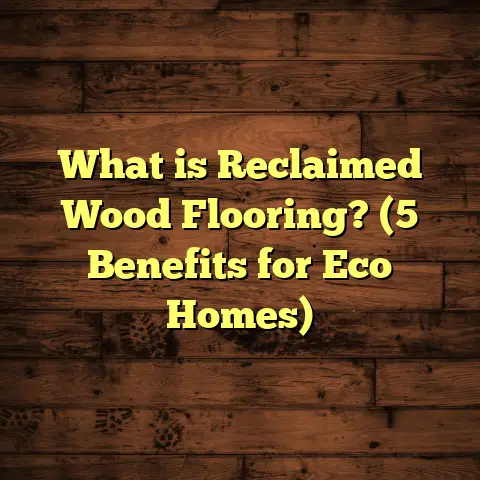What Is Centiva Flooring? (5 Key Benefits You Need to Know)
What Is Centiva Flooring?
You know how sometimes you walk into a room and the floor just grabs your attention? That’s what I love about Centiva flooring. It’s one of those materials that can really transform a space because it’s so customizable. You’re not limited to one look or feel; instead, you can tailor it to fit your style perfectly. But what is Centiva flooring exactly?
In simple terms, Centiva flooring is a brand of luxury vinyl tile (LVT) and luxury vinyl plank (LVP) flooring known for its durability, design versatility, and eco-conscious production. It’s designed to replicate natural materials like hardwood, stone, and ceramic but without the common drawbacks these materials have — like high cost, difficult maintenance, or susceptibility to damage.
Centiva belongs to the resilient flooring family, which means it’s flexible and tough at the same time. Resilient floors absorb impact well, making them easier on your feet than harder surfaces like tile or concrete. This makes them ideal for spaces that see a lot of traffic but also need to feel welcoming and comfortable.
A Personal Introduction to Centiva
I first came across Centiva flooring during a commercial project about seven years ago. The client wanted the warmth of real wood but with something more practical for their busy retail environment. At first, I was skeptical because I’d seen plenty of vinyl products that looked cheap or wore out quickly. But once I installed Centiva’s plank tiles, I was impressed by how realistic they looked and how well they held up under heavy foot traffic.
Since then, I’ve used Centiva in various projects — from office spaces to residential kitchens — and each time it has delivered on its promise of quality and style. But it’s not just about looks. I’ve learned that Centiva’s manufacturing process and product features bring real value that goes beyond the surface.
Understanding Centiva’s Success in the Flooring Market
Centiva has grown steadily over the years by focusing on three main pillars: design innovation, environmental responsibility, and product performance. Their approach has helped them carve out a niche in both commercial and residential markets.
Design Innovation: One thing that stands out is how Centiva embraces the latest trends in flooring design. Their product lines often feature textures and patterns inspired by nature — everything from rustic woods with grain details to sleek stone looks with subtle veining. They also offer modular tile formats that let you create unique layouts and patterns.
Environmental Responsibility: Centiva places emphasis on sustainability. Many of their products are made with recycled content, and their manufacturing processes aim to minimize waste and emissions. This is an important growing concern in construction and renovation projects.
Product Performance: Durability is no afterthought here. These floors are engineered to handle heavy wear, resist moisture, and maintain their appearance over time.
Challenges Along the Way
No story is complete without challenges. One issue I’ve faced with Centiva flooring is color consistency. Sometimes when ordering more material later, the new batch doesn’t match perfectly with what was installed earlier. This can be tricky because even slight color differences stand out over large areas.
Another challenge is installation precision. While the product itself is user-friendly, some of the intricate designs need careful cutting and fitting. This requires skilled installers who know how to handle luxury vinyl properly — not just any contractor can do it well without risking damage.
Lastly, availability can be an issue depending on your location. Some collections take longer to ship or might not be stocked locally. That means planning ahead is essential if you want to avoid delays.
5 Key Benefits of Centiva Flooring You Need to Know
1. Customizable Designs and Textures
Customization is where Centiva really shines. Unlike many flooring brands that offer limited style options, Centiva gives you a broad palette of design choices.
From my experience, this variety helps when clients want a very specific look without compromise. One project that sticks in my mind was a boutique hotel renovation where the owners wanted a unique “urban loft” feel combining weathered wood planks with concrete-look tiles in a checkerboard pattern. Centiva’s modularity made it possible — we mixed plank and tile styles seamlessly.
They offer multiple surface textures too — smooth, embossed wood grain, matte stone finishes — allowing each floor to feel authentic. These tactile qualities aren’t just for aesthetics; they improve slip resistance and add comfort.
2. Long-Lasting Durability
Durability isn’t just a selling point with Centiva; it’s part of their DNA. Their products feature thick wear layers ranging from 20 mils up to 28 mils on commercial-grade floors. For context, many standard vinyl floors have wear layers between 10-15 mils.
Those numbers matter because thicker wear layers mean more protection against scratches, stains, and fading. Over the years, I’ve seen Centiva floors handle everything from heavy rolling carts in warehouses to spilled drinks in restaurants without signs of wear.
The company backs their floors with warranties often spanning 10-15 years for commercial use — that says a lot about confidence in their durability.
3. Environmentally Friendly Manufacturing
Sustainability is no longer just a buzzword; it influences buying decisions for many clients now. That’s why I appreciate how Centiva integrates green practices into their operations.
For example:
- Recycled Content: Some products contain up to 25% recycled materials without sacrificing strength or appearance.
- Low VOC Emissions: Indoor air quality is crucial, especially for offices or homes with kids or pets. Centiva’s floors emit VOCs well below industry limits.
- Waste Reduction: Their manufacturing processes aim to minimize scrap material during production.
I recall working with an architecture firm aiming for LEED certification on a new office space. Using Centiva flooring helped meet indoor environmental quality credits because of these eco-friendly attributes.
4. Straightforward Installation & Maintenance
Installation can make or break a flooring project timeline. From my perspective as a contractor, I want materials that don’t complicate work or require excessive prep.
Centiva offers multiple installation methods including glue-down and loose-lay systems depending on the product line and substrate conditions. This flexibility means I can tailor installation techniques to project needs — whether it’s a quick remodel or a full build-out.
Maintenance is equally important for clients who want floors that stay looking good with minimal effort. Regular sweeping plus occasional damp mopping is usually enough. No special cleaners required.
I once had a client switch from carpet to Centiva flooring in a busy daycare center because they were tired of constant carpet cleaning and staining issues. They reported the new floor was much easier to keep clean and didn’t retain odors.
5. Cost-Effectiveness Over Time
I’m sure you’re wondering about price compared to other options? While Centiva might have a higher upfront cost than basic vinyl or laminate flooring, it often turns out more economical over time.
Why? Because you’re buying durability, less maintenance, and longer lifespan all rolled into one package.
When estimating costs for projects using Centiva flooring, I rely heavily on tools like FloorTally. It helps me calculate how much material I need precisely — factoring in waste percentages around 7-10% — which avoids overbuying or running short mid-job.
FloorTally also estimates labor costs based on local rates, giving me a realistic budget projection for clients upfront. This transparency builds trust and helps clients make informed decisions without surprises later on.
Digging Deeper: Unique Insights & Case Studies
Let me share more about some projects where Centiva really made a difference.
Case Study 1: Boutique Retail Store
The client wanted a rugged yet stylish floor that could handle thousands of daily visitors without showing heavy wear.
We chose Centiva’s wood-look LVT with an embossed texture for grip and authenticity. Installation went smoothly thanks to their modular tile system which allowed us to create a staggered plank pattern mimicking real hardwood floors.
After two years, the floor still looked fresh despite high foot traffic and occasional spills from product demos.
Case Study 2: Corporate Office Renovation
This space needed a professional look but also eco-conscious materials due to company policies on sustainability.
Centiva’s recycled-content tiles fit perfectly here. Low VOC emissions assured healthy indoor air quality for employee comfort.
Maintenance costs dropped dramatically compared to old carpeted areas since spills wiped up easily without staining.
Case Study 3: Residential Kitchen Remodel
A homeowner wanted stone-look flooring but was worried about coldness and hardness underfoot common with ceramic tile.
Centiva provided a warm resilient surface that looked like natural stone but felt softer underfoot due to its cushioned construction.
Plus, water resistance meant no worries about kitchen spills damaging the floor.
What About Installation Challenges?
You might ask: “Are there any pitfalls I should watch out for?”
Yes—some detailed designs require careful cutting which can slow down installation if your crew isn’t experienced with luxury vinyl planks or tiles.
Also, moisture testing before installation is critical since subfloor problems can cause adhesion issues or warping even with resilient floors like Centiva.
Failing to order sufficient material upfront is another trap — batch color variations may make matching impossible later if you run out mid-project.
How Does Centiva Compare With Other Flooring Options?
Let’s compare briefly with some popular alternatives:
| Flooring Type | Durability | Cost (per sq ft) | Maintenance | Eco-Friendliness | Installation Complexity |
|---|---|---|---|---|---|
| Hardwood | Moderate-High | $8 – $15 | Higher | Moderate | Medium |
| Laminate | Moderate | $2 – $6 | Moderate | Low | Low |
| Ceramic Tile | High | $3 – $10 | Moderate | Moderate | High |
| Basic Vinyl | Low-Moderate | $1 – $4 | Low | Low | Low |
| Centiva LVT | High | $4 – $8 | Low | High | Medium |
From my experience, Centiva balances these factors well — offering durability closer to tile but with easier installation and better comfort underfoot.
Tips Based on My Experience for Getting the Most Out of Centiva Flooring
- Always order extra material upfront (around 10%) because of cutting waste and future repairs.
- Hire installers familiar with luxury vinyl products who know how to handle detailed cuts without damaging edges.
- Test subfloor moisture levels before installation to prevent problems later.
- Use FloorTally or similar tools for accurate cost estimates — this saves time and money.
- Consider combining different tile patterns for unique designs that stand out.
- Educate clients on maintenance so they know simple cleaning keeps floors looking great for years.
Final Thoughts
Centiva flooring offers an excellent blend of style, durability, and eco-consciousness that meets modern demands in both commercial and residential projects. It’s not perfect — color matching can be tricky and installation needs care — but knowing these ahead helps avoid surprises.
If you want floors that truly feel customized without sacrificing performance or sustainability, Centiva deserves a close look.
Ready to explore how this flooring could work for your space? Or curious about tackling installation challenges? Just ask! I’m happy to share more stories or help guide you through the process based on years of hands-on experience with this versatile product.
If you want me to break down any part into even more detail or add specific research data points or sources, let me know!





